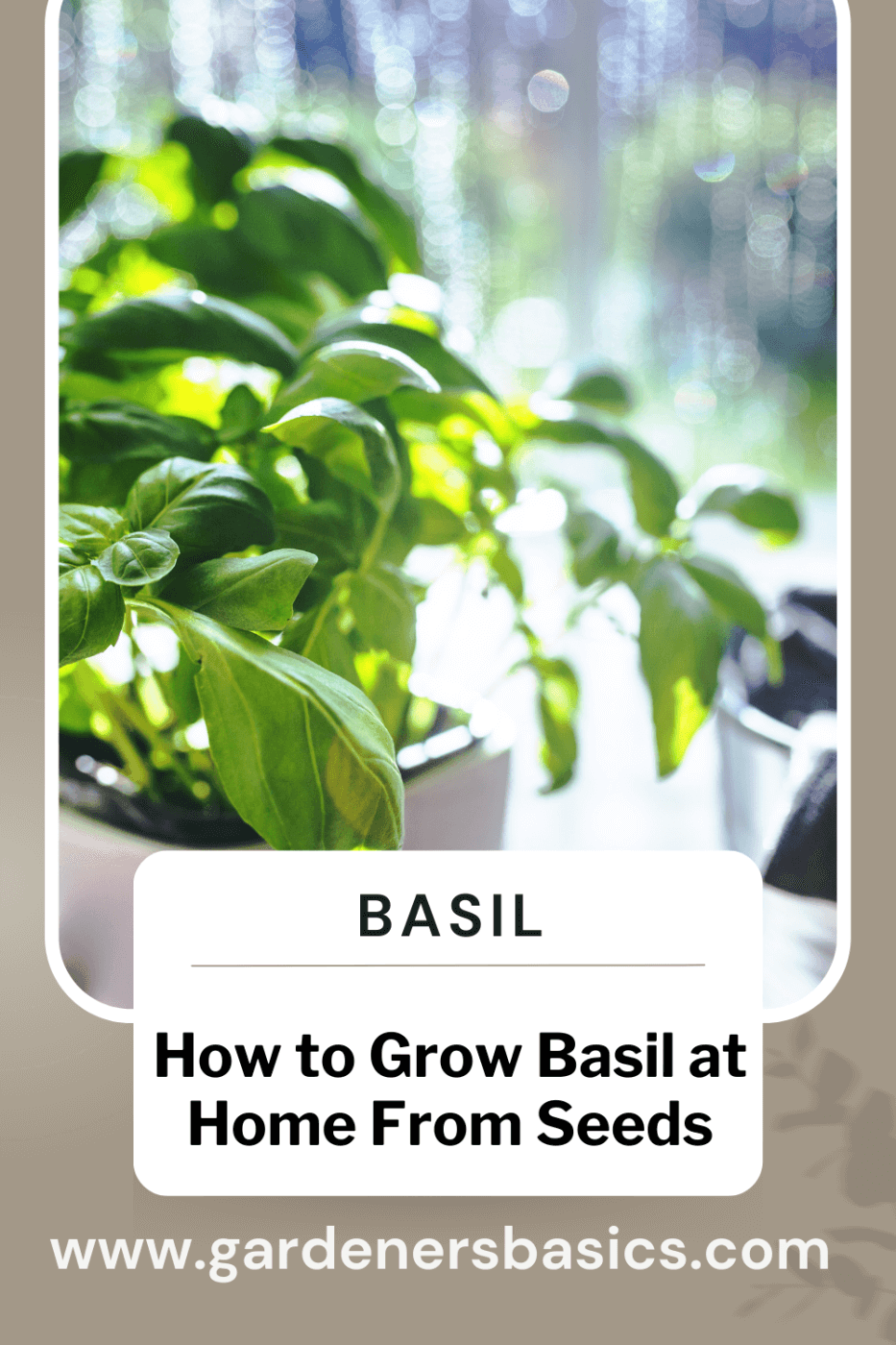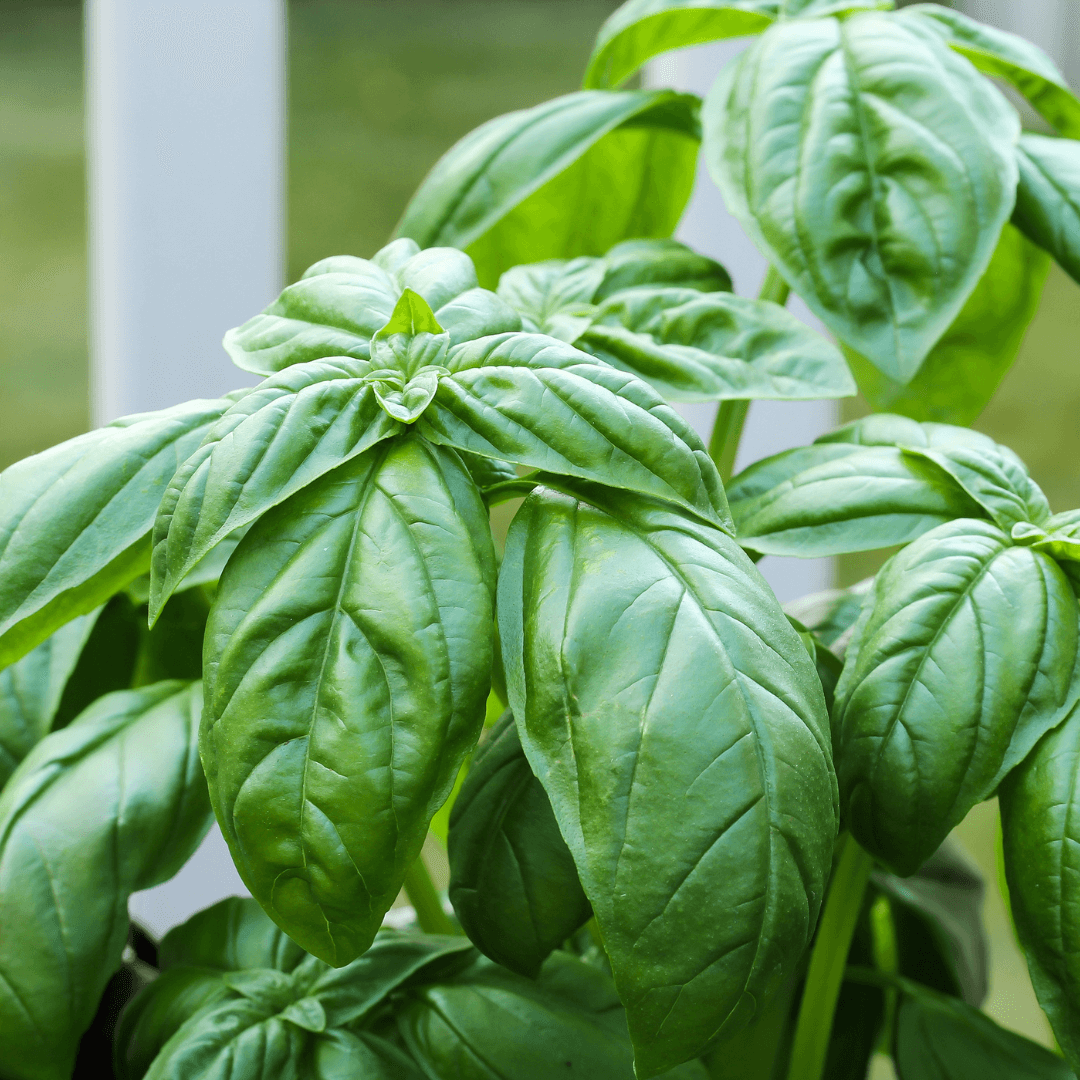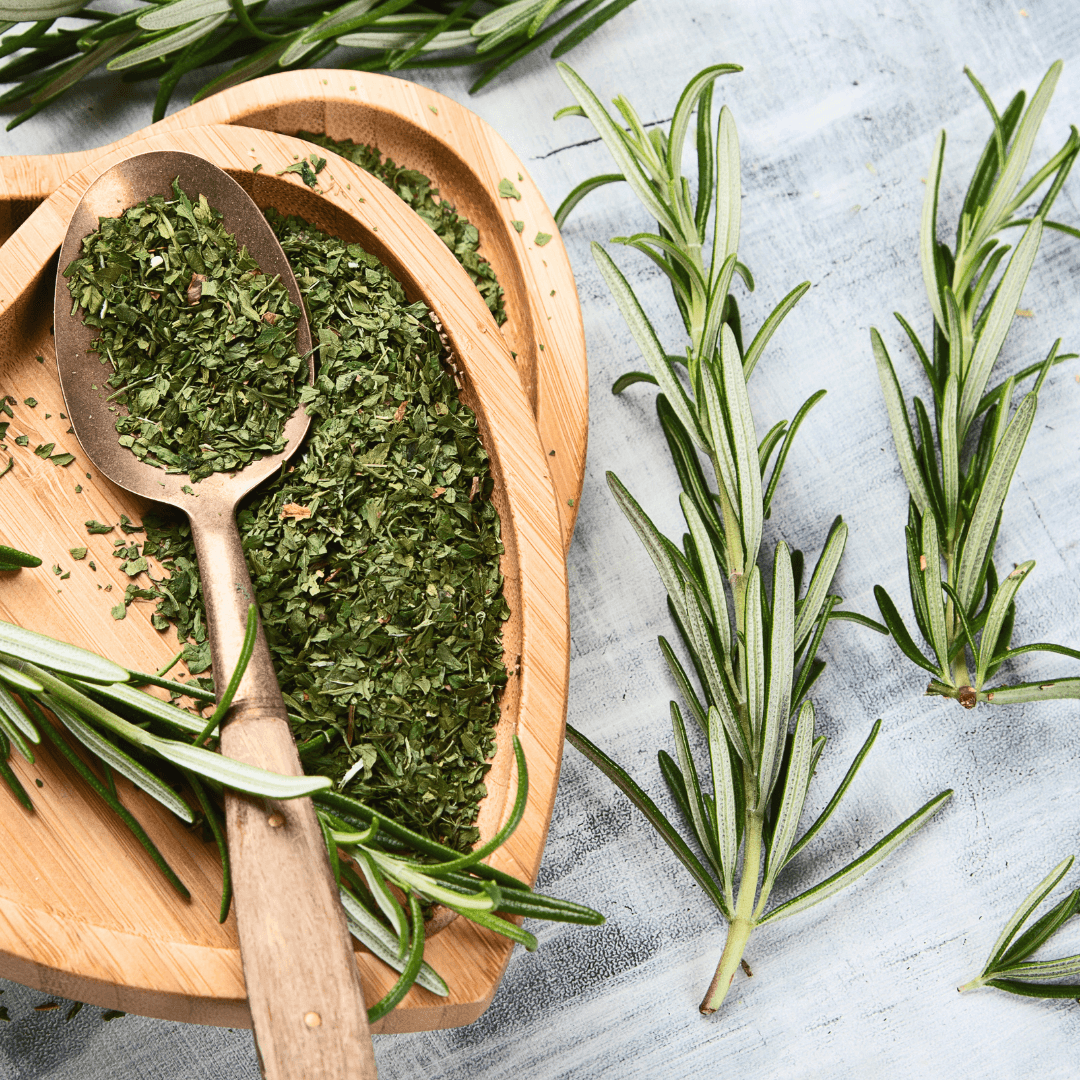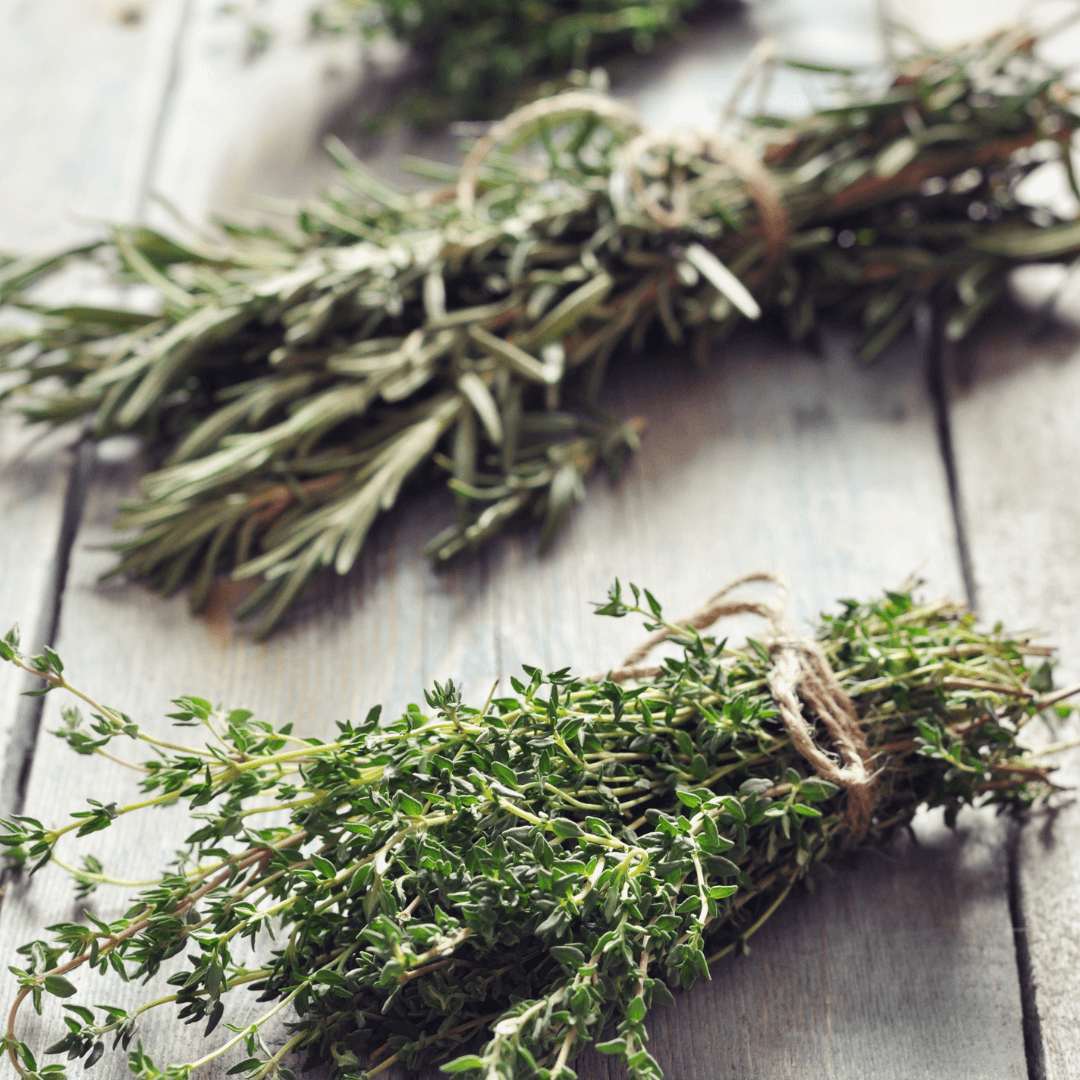Growing basil at home from seeds is not only an easy and rewarding task, but it also provides a versatile herb that can be used in various dishes. With its fragrant leaves and distinct flavor, Basil is a popular herb used in many cuisines. In this article, as an avid female gardener, I will guide you through how to grow basil at home from seeds, step by step. Following these instructions, your lush basil plants will soon be ready for harvest.
1. A Brief History of Basil and Its Different Varieties
Basil (Ocimum basilicum) is a mint family member and native to India, Africa, and Asia. This versatile herb has been cultivated for over 5,000 years for its culinary, medicinal, and aromatic properties. Over time, different varieties of basil have been developed, including sweet basil, Thai basil, and purple basil. You can find a wide range of basil seeds at Gardeners Basics to start your own basil garden at home.
The Many Faces of Basil
There are countless basil varieties to choose from, with each offering a unique flavor and appearance. Some popular types include:
- Sweet basil: The most common variety, with a sweet and slightly peppery flavor.
- Thai basil has a licorice-like taste and is essential in Thai cuisine.
- Purple basil: Boasts vibrant purple leaves and a milder flavor than sweet basil.
- Lemon basil: Features a distinct lemony flavor, perfect for fish dishes and salads.
- Cinnamon basil: As the name suggests, this variety has a cinnamon-like aroma and taste.
Genovese Basil Seeds

$2.49
Premium Heirloom Genovese Basil Seeds – Non-GMO, Non-Hybrid, Open-Pollinated – Perfect for Culinary Herb Gardens Grow the classic flavor of Italy with Genovese Basil seeds, perfect for home gardeners, culinary enthusiasts, and herb lovers. These heirloom, non-GMO, non-hybrid, open-pollinated seeds are… read more
2. Choosing the Right Seeds and Understanding Their Characteristics
When selecting basil seeds, it's essential to understand the specific characteristics of each variety. Here are some key factors to consider when choosing your sources:
- Days till maturity: Basil typically takes 60-90 days to reach maturity, depending on the variety.
- Planting depth: Sow basil seeds ¼ inch deep in the soil.
- Plant spacing: Space basil plants 12-18 inches apart.
- Days to germination: Basil seeds usually germinate within 5-10 days.
- Sunlight requirements: Full sun is ideal, but basil can tolerate partial shade.
- Plant size: Depending on the variety, basil plants can grow 12-24 inches tall and 12-18 inches wide.
Growing Conditions
Basil is a warm-weather plant that thrives in temperatures between 65-85°F. It is sensitive to frost, so waiting until the danger of frost has passed before transplanting seedlings outdoors is essential.
3. Seed Starting: Preparing for Success
To ensure successful basil seeds germination, follow these seed-starting tips:
- Choose a high-quality, well-draining potting mix.
- Moisten the potting mix before sowing seeds.
- Use seed trays or small pots with drainage holes to avoid over-watering.
- Place seed trays or pots in a warm location, ideally between 65-75°F.
Seed Starting Indoors vs. Direct Sowing
Basil seeds can be started indoors or direct sown into your garden. Starting seeds indoors allows for better control over growing conditions and can result in more vigorous plants. However, direct sowing is more straightforward and eliminates the need for transplanting.
4. Sowing Your Basil Seeds
When sowing your basil seeds, follow these steps:
- Fill seed trays or small pots with moistened potting mix.
- Plant seeds ¼ inch deep and cover them with potting mixture.
- Gently mist the soil with water to maintain moisture.
- Place the trays or pots in a warm location.
- Check daily for signs of germination and keep the soil evenly moist.
Basil Seeds For Planting | 5 Variety Pack
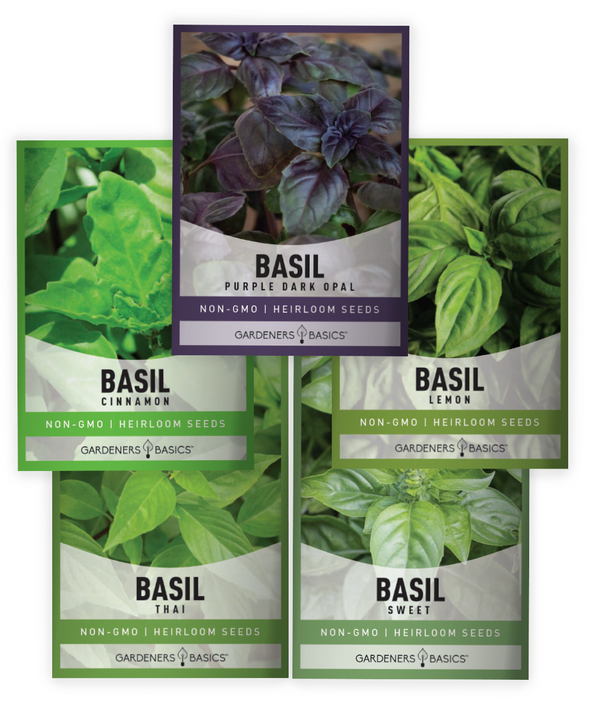
$9.95
5 Basil Seeds Variety Pack – Grow Aromatic, Flavorful Basil from Non-Hybrid, Open-Pollinated Seeds Introducing our 5 Basil Seeds Variety Pack – the perfect choice for any herb garden enthusiast or culinary adventurer. This premium selection of basil seeds offers an… read more
5. Transplanting Basil Seedlings
After your basil seedlings have developed their first set of true leaves, it's time to transplant them:
- Choose a location in your garden with full sun or partial shade.
- Prepare the soil by loosening and mixing it in compost or organic matter.
- Carefully transplant seedlings, maintaining their original soil depth.
- Space plants 12-18 inches apart, depending on the variety.
Acclimating Seedlings to Outdoor Conditions
Before transplanting seedlings outdoors, it's essential to gradually acclimate them to outdoor conditions. This process, known as "hardening off," involves exposing seedlings to outdoor temperatures and sunlight for a few hours each day, gradually increasing the duration over a week or two.
6. Caring for Your Basil Plants
To ensure a healthy and productive basil plant, follow these care tips:
- Watering: Maintain consistent soil moisture without over-watering. Allow the soil to dry slightly between waterings.
- Fertilizing: Use a balanced, slow-release fertilizer or organic compost to feed your basil plants.
- Pruning: Regularly prune basil by pinching off the tips of the stems to encourage bushy growth and prevent flowering.
- Companion planting: Plant basil alongside tomatoes, peppers, and herbs to deter pests and improve flavor.
- Pest control: Watch for aphids, whiteflies, and other pests. Use organic pest control methods or insecticidal soap when necessary.
Mulching and Weed Control
To maintain soil moisture and suppress weeds, apply a 2-3 inch layer of organic mulch around your basil plants. This will help to regulate soil temperature and reduce the need for frequent watering.
7. Harvesting Your Basil Leaves
To enjoy the fresh taste of homegrown basil, follow these harvesting tips:
- Start harvesting basil leaves once the plant is 6-8 inches tall.
- Harvest in the early summer, when the plant is most flavorful.
- Pick leaves in the morning, after the dew has dried, for the best taste and aroma.
- Regularly harvest leaves to encourage growth and prevent the plant from becoming too tall and leggy.
Storing and Preserving Basil
Fresh basil can be stored in the refrigerator for up to a week by placing the stems in a glass of water and covering the leaves with a plastic bag. To preserve basil for extended periods, dry the leaves or make pesto and freeze it in ice cube trays for easy portioning.
8. Enjoying Your Homegrown Basil in Various Dishes
Now that you have successfully grown and harvested your basil, it's time to savor the fruits of your labor. Basil is a versatile herb that can be used in a wide range of dishes, such as:
- Pesto: Combine basil leaves, pine nuts, garlic, Parmesan cheese, and olive oil for a classic Italian sauce.
- Caprese salad: Layer fresh basil leaves, sliced tomatoes, and mozzarella cheese for a refreshing summer dish.
- Thai basil stir-fry: Use Thai basil leaves in your favorite stir-fry recipe for an aromatic and flavorful twist.
- Lemon basil vinaigrette: Blend basil leaves, lemon juice, olive oil, and garlic for a zesty salad dressing.
Herb Seed Assortment | 15 Variety Pack
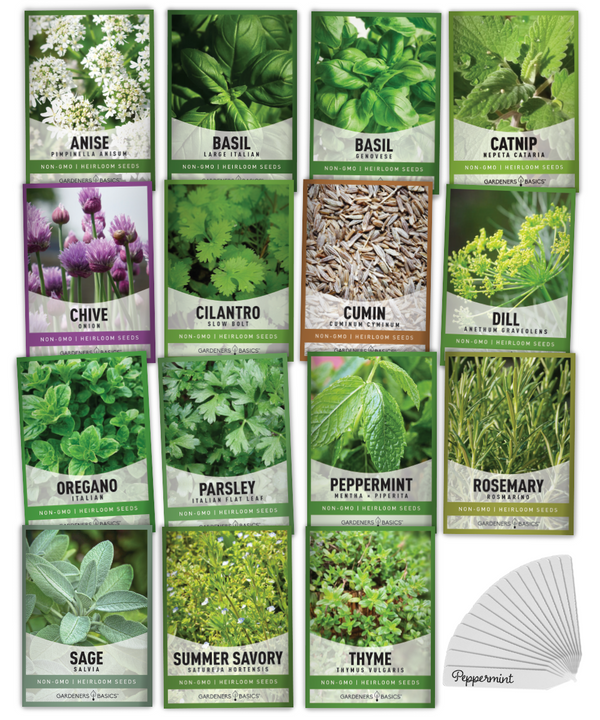
$19.95
Unlock the Power of Homegrown Herbs: 15 Heirloom Herb Seeds for Sustainable Gardening Introducing our 15 Herb Seeds Variety Pack—the ultimate collection for any home gardener, herbalist, or culinary enthusiast looking to grow fresh, flavorful herbs. Each of the 15 herb… read more
Expanding Your Herb Garden
Once you have successfully grown basil, you may also be inspired to grow other herbs. Some popular herbs that pair well with basil in both the garden and the kitchen include:
- Parsley: A versatile herb used in many dishes, parsley is easy to grow and has a bright, fresh flavor.
- Cilantro: Widely used in Mexican and Asian cuisines, cilantro has a bold, citrusy taste and is an excellent addition to salsas and salads.
- Mint: With its refreshing flavor, mint is perfect for teas, cocktails, and desserts. It can be invasive, so it's best grown in containers.
- Rosemary: A hardy, aromatic herb, rosemary adds depth to roasted meats, vegetables, and bread.
The Health Benefits of Basil
In addition to its culinary uses, basil also offers numerous health benefits. It is a rich source of vitamins A, C, and K and minerals like calcium, iron, and potassium. Basil is also known for its anti-inflammatory and antioxidant properties, which can help to support overall health and well-being.
In conclusion, growing basil at home from seeds is a rewarding and enjoyable endeavor that yields a versatile and flavorful herb. By following this comprehensive guide, you'll be well-equipped to cultivate a thriving basil garden and enjoy the many benefits of homegrown herbs. Don't forget to visit the Gardeners Basics store for all your seed and gardening needs, and explore the world of homegrown herbs to elevate your cooking and enhance your garden.
Conclusion
By following this in-depth, step-by-step guide, you'll be well on your way to successfully growing basil at home from seeds. Remember to choose suitable sources, provide proper care, and regularly harvest your basil plants to enjoy fresh, flavorful basil leaves growing seasonally. Visit our store to find the perfect basil seeds for your garden and explore other herb seeds to expand your homegrown collection.
Frequently Asked Questions - How to Grow Basil At Home From Seeds
Q: How long does it take for basil seeds to germinate?
A: Basil seeds typically germinate within 5-10 days.
Q: How deep should I plant basil seeds?
A: Basil seeds should be planted ¼ inch deep in the soil.
Q: How much sunlight do basil plants need?
A: Basil plants prefer full sun but can tolerate partial shade.
Q: How far apart should I space my basil plants?
A: Depending on the variety, space basil plants are 12-18 inches apart.
Q: When is the best time to harvest basil leaves?
A: Harvest basil leaves in the early summer when the plant is most flavorful. Pick leaves in the morning, after the dew has dried, for the best taste and aroma.
Q: Can basil seeds be started indoors?
A: Yes, basil seeds can be started indoors, which allows for better control over growing conditions and can result in more vigorous plants.
Assorted Gourmet Basil Seed Varieties | 8 Variety Pack
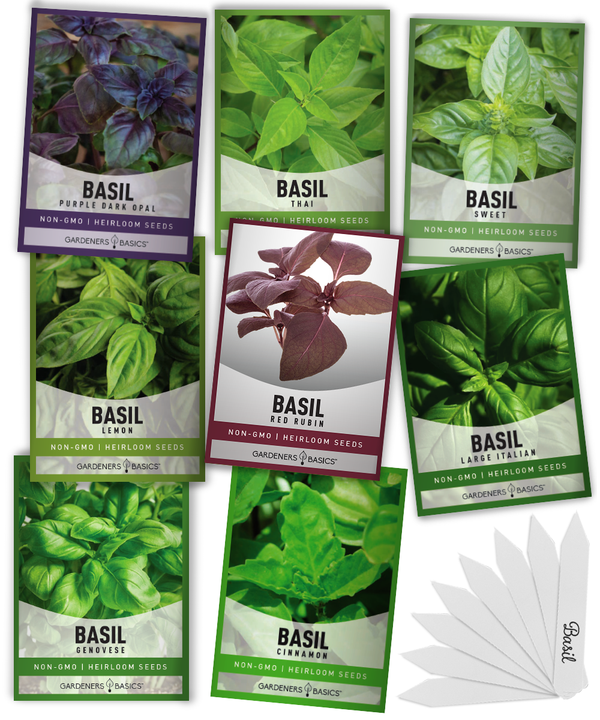
$15.95
The Ultimate Gourmet Basil Seeds Pack: 8 Varieties of Heirloom, Non-Hybrid Basil Introducing our 8 Gourmet Basil Seeds Variety Pack, the ultimate choice for basil lovers and home gardeners! This carefully curated selection of heirloom basil seeds includes non-hybrid, open-pollinated, and… read more
Q: How do I prune my basil plant?
A: Prune your basil plant by pinching off the tips of the stems to encourage bushy growth and prevent flowering.
Q: What are some popular dishes that use basil?
A: Basil can be used in various dishes, such as pesto, Caprese salad, Thai basil stir-fry, and lemon basil vinaigrette.
Q: Can I grow other herbs alongside my basil plants?
A: Yes, basil can be grown alongside other herbs like parsley, cilantro, mint, and rosemary. Companion planting can help deter pests and improve flavor.
Q: What are the health benefits of basil?
A: Basil is a rich source of vitamins A, C, and K, as well as minerals like calcium, iron, and potassium. It also has anti-inflammatory and antioxidant properties, which can help support overall health and well-being.





